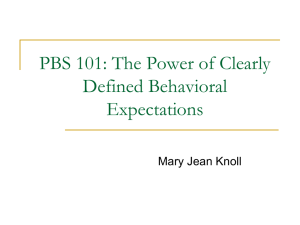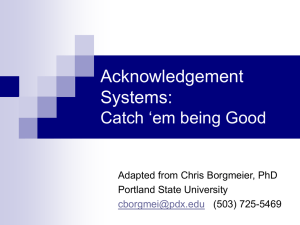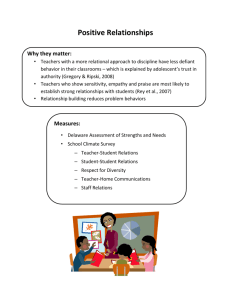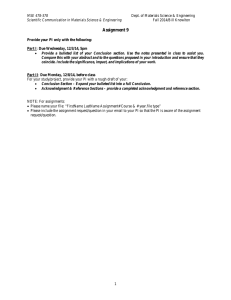Sunrise PBS Overview Adapted from Chris Borgmeier, PhD & Kimberly Ingram, PhD
advertisement
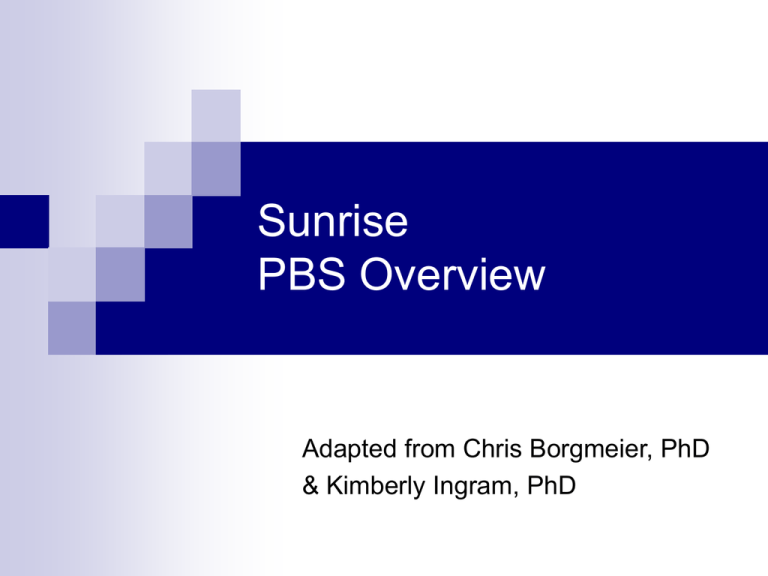
Sunrise PBS Overview Adapted from Chris Borgmeier, PhD & Kimberly Ingram, PhD Positive Behavior Support PBS is a broad range of systemic & individualized strategies for achieving important social & learning outcomes while preventing problem behavior with all students. Positive Behavior Support Is based on decades of research from the fields of: Behavioral theory Effective Instruction Systems Change PBS is Not specific practice or curriculum…it is a general approach to preventing problem behavior Not limited to any particular group of students…it is for all students Not new…it is based on long history of behavioral practices & effective instructional design & strategies Components of SW PBS 1. School-wide System SW-PBS Team School Rules Define & Teach: 2. Expectations Routines Acknowledgment System Consequences & Decision Making Handbook Focus of Year 1 Classroom Support 3. Training/ Support opportunities Individual Teacher Support Individual Student System Targeted Group Interventions FBA/BSP – Intensive Individualized Interventions Years 2-3: Continuing Development 1. School-wide System SW-PBS Team School Rules Define & Teach: 2. Expectations Routines Acknowledgment System Consequences & Decision Making Handbook Classroom Support 3. Training/ Support opportunities Individual Teacher Support Individual Student System Targeted Group Interventions FBA/BSP – Intensive Individualized Interventions Focus of Years 2 & 3 PBS: Defining Features Teaching Expected Behavior Increase Structure and Predictability by explicitly teaching Behavioral Expectations and Routines. Reduce the mystery and chaos by making expectations explicit through formal teaching Develop a “United Front” across all staff through consistent language & expectations Increased Structure + Decreased Chaos = Fewer Problems PBS: Defining Features Acknowledging Socially Competent (Expected) Behavior Teaching alone is not enough, we also need to regularly Reinforce students for following expectations Improving the School Climate By increasing the number of Positive Interactions between staff and students we are improving the school climate & building relationships. PBS: Defining Features Responding to Inappropriate Behavior Consistency among staff Deciding on consequences for each type of behavior Office-managed problem behavior versus Staff-managed problem behavior E.g., re-teaching school rules at “Rule School” for multiple displays of ‘Staff-managed Behavior’ When does a staff-managed problem turn into an office-managed problem? Using data for Decision Making Deciding on a system to collate data (eSIS, Excel, paper and pencil) – that will allow team to quickly examine data summaries and trends Teaching Behavioral Expectations & Routines Basic Strategy for Establishing Behavioral Routines 1. 2. 3. 4. 5. 6. Explain Specify Student Behaviors Model Desired Behavior Lead - Student Practice – each individual student should get an opportunity to practice the routine Test/ Monitor Follow-up -- reinforce & review regularly Teaching Behavioral Expectations & Routine Make lessons fun and engaging, just like any lesson should be Make instruction developmentally appropriate Lessons can be more challenging with older kids; may rely more on verbal explanation of rules, with practice as a response for not following rules & regular reinforcement for following rules Although, practice is always very valuable Choose skills to teach wisely Presentation & attitude are important Acknowledgment Systems Purpose: To reinforce school rules, behavioral expectations & positive behavior Negatives Positives Promote a more positive school environment School-wide 5:1 positive/negative interaction ratio Regular school-wide celebration of positive behavior Increase positive interactions between staff & students Prompt busy adults to remember to reinforce positive behavior School-wide Foundation It is important that an Acknowledgment system is accessible to ALL students all the time Schools can also have other systems for recognizing students Classroom reward system in addition to school-wide system Perfect attendance Honor Roll Positive Behavior Support Social Competence & Academic Achievement OUTCOMES Supporting Decision Making Supporting Staff Behavior PRACTICES Supporting Student Behavior Positive Behavior Support Social Competence & Academic Achievement OUTCOMES Supporting Decision Making Supporting Staff Behavior PRACTICES Supporting Student Behavior Acknowledgment Systems Big pay-off for limited expense Immediate reinforcement with tickets that are accessible to all students Link with school wide celebration of positive Lottery system helps to keep incentives cheap behavior Lot of kids have chance to win… but pay out is cheap Small tangible rewards Public recognition is often powerful Acknowledgment Systems Research shows that when we 1) Set our standards for reinforcement high (set a high level of performance) and 2) Don’t give rewards each and every time behavior(s) occur (make it unexpected) The likelihood that behavior decreases over time (e.g.decrease in intrinsic motivation) does not occur Cameron, J., K.M., Pierce, W.D. (2001). Pervasive Negative Effects of Rewards on Intrinsic Motivation: The Myth Continues. The Behavior Analyst, 24, 1-44. (Meta-analysis that examines two previous meta-analysis (Cameron & Pierce (1994) and Deci, Koestner & Ryan (1999)) - with differing results pertaining to effects of praise and tangible rewards on intrinsic motivation. Focus of Acknowledgment System Beginning of year Heavy emphasis on reinforcing all school rules & expectations As year progresses and specific areas of concern come up in the school Can begin to target specific behaviors or areas that the data has shown to be difficult i.e. hallway behavior, appropriate language, etc. Returning from breaks, or entering months in which there were higher referrals in previous years May want to re-teach expectations & remind staff to boost up use of acknowledgments Frequently Asked Questions Should we track Positive Referrals? Track it broadly, not individually Are teachers going through enough referral pads? How many should be given out? Better to err on the side of more than less Need to be genuine & verbally paired w/ reason, not handed out indiscriminately Frequently Asked Questions Shouldn’t students be expected to do these things without being rewarded? 1) 2) 3) 4) Sure, BUT students are bringing a varied set of experiences and skills to school, unfortunately some students may not get enough acknowledgment at home How many of you feel you get acknowledged often enough for the work you do? This system should not replace regular verbal praise and pats on the back for students …all this system provides in addition for most students is a small piece of paper This system is as much to help remind the adults to catch kids doing the right thing in school… we get busy and too often get caught up focusing on predominantly negative behavior (5 to 1 ratio) P B S I n c i d e n t T ri a n g l e QuickTime™ and a TIFF (Uncompressed) decompressor are needed to see this picture. Office vs Staff Managed QuickTime™ and a TIFF (Uncompressed) decompressor are needed to see this picture.
